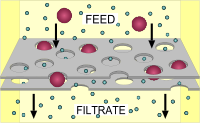
Photo from wikipedia
In most ecosystems, a large part of the organic carbon is not solubilized in the water phase. Rather, it occurs as particles made of aggregated hydrophobic and/or polymeric natural or… Click to show full abstract
In most ecosystems, a large part of the organic carbon is not solubilized in the water phase. Rather, it occurs as particles made of aggregated hydrophobic and/or polymeric natural or man-made organic compounds. These particulate substrates are degraded by extracellular digestion/solubilization implemented by heterotrophic bacteria that form biofilms on them. Organic particle-degrading biofilms are widespread and have been observed in aquatic and terrestrial natural ecosystems, in polluted and man-driven environments and in the digestive tracts of animals. They have central ecological functions as they are major players in carbon recycling and pollution removal. The aim of this review is to highlight bacterial adhesion and biofilm formation as central mechanisms to exploit the nutritive potential of organic particles. It focuses on the mechanisms that allow access and assimilation of nondissolved organic carbon, and considers the advantage provided by biofilms for gaining a net benefit from feeding on particulate substrates. Cooperative and competitive interactions taking place in biofilms feeding on particulate substrates are also discussed. This article is protected by copyright. All rights reserved.
Journal Title: Environmental microbiology reports
Year Published: 2019
Link to full text (if available)
Share on Social Media: Sign Up to like & get
recommendations!